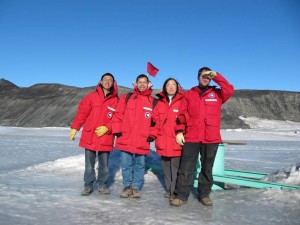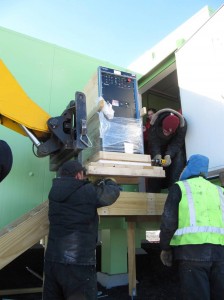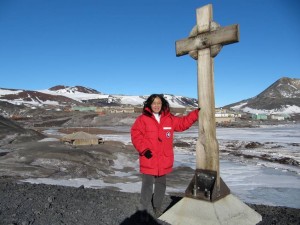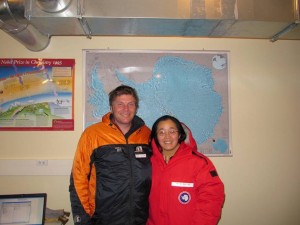Happy thanksgiving from McMurdo, Antarctica, although a few days late!
What a busy and tough week we had on the ice! Construction, moving, unpacking and installation become so difficult in this cold world! Seawater-moisture, damaged power console and broken frames were the subject of this week, but at the end victory smiled upon us!
Starting on Monday, we verified the lidar floor plan at Arrival Heights Lab C, and communicated with both USAP and ANZ folks to coordinate the move of two laser power consoles, mounting frames and main optical bench. A meeting among A-130 lidar team, USAP POC, FEMC (Facilities, Engineering, Maintenance, and Construction) manager, two safety representatives and ANZ Scott Base manager was held on Tuesday morning to discuss how to move in the two alexandrite laser power consoles in DNF (Do Not Freeze) conditions. Then the real move began on Tuesday afternoon. We timed the procedure – it cost 40 minutes for one power console: 20 minutes transport from McMurdo Station to Arrival Heights on a flatbed truck, 10 minutes to get the crate onto the small landing area with a fork lift, and then 10 minutes to take apart of the crate and move the power console inside. With blankets wrapping the power console, it was kept at normal temperature through the whole process. The Kiwis did a really nice job!
Unfortunately, once the power consoles were moved into Lab C, we quickly found rusted screws on one of the power consoles. Inspection inside the console indicated some seawater moisture damage! I was quite upset by this outcome. Blame wouldn’t help, it was time to look for solutions. An email to Dr. John Walling and Doug Gustavson of Light Age, Inc. (LAI – the laser manufacturer) immediately triggered their enthusiastic responses – they sent us detailed instructions on how to clean up the corrosion. This is just like old days when we did the South Pole and Rothera campaigns, LAI people were always willing to help!!! We did the cleaning but had to wait until next week when the electrical power is available to test whether the power console is still OK. With Dr. Walling and Doug behind us, we are confident we will get it to work again.
Wednesday was a frustrating day as we found the 12-ft long mounting frames were broken! When the Kiwi carpenters Russell and Dean informed me this at Arrival Heights, my first thought was: “I’m going to kill Matt Rhode! He didn’t even pack the frames well?!” Matt is in charge of Aerospace Department machine shop and he helped us pack the entire frames before the shipment to Antarctica. He has done so much good work for us in the past. How could he not pack the frames right? No time to think more, but I had to call Brian Johnson, our POC at McMurdo, to ask him to take the frames back to the station for repair. To our surprise, within 20 minutes, several important guys from the McMurdo Station came to Arrival Heights, including the cargo manager Michael Davis and FEMC manager John Meyers.
— Michael said “I know exactly how your frames were broken?”
— “How?” I responded with wide-open eyes.
— “The crate fell 8 feet when being transported from the McMurdo ice runway to the station, due to an accident …”
It doesn’t matter to me what the accident was, but it matters that Matt is off the hook. No matter how he packed the frames, the 1200 lbs of metal wouldn’t survive an 8-foot fall! Inspection showed that Matt actually did an excellent job in packing the frames – his way of packing kept the top frame flat even in such an accident. This was very important to our optical bench and receiver plates’ mounting and leveling. Many thanks to Matt!!! The broken parts were welded metal, and they were repairable. FEMC manager John Meyers immediately offered help and asked his engineers at the heavy machine shop to take back the frames, repair and then assemble them together.
Dr. Wentao Huang, our research scientist, spent his entire Thursday working with Ken and two other engineers at machine shop to repair and assemble the mounting frames. John Meyers brought us to the shop after lunch, and I was amazed that Antarctica has a machine shop that could handle heavy and large size equipment! The repair was done beautifully, and by Friday 10am, the assembled frames were moved back to Arrival Heights.
The drama started around 1:30pm on Friday when four Kiwi engineers came to help us disassemble the frames and then move them into Lab C. Things went very smoothly with these talented Kiwi people and our dedicated team members Wentao Huang, Weichun Fong and John Smith. The over 1000 lbs frames were moved in, positioned precisely, re-assembled and leveled within two hours! I was very pleased.
What made me really happy that day was that the 800-pound optical bench was also moved in and mounted to the frames. This was a wish that I wrote to Jonathan Leitch, the Kiwi manager, on Thursday night and it was “criticized” as “a bit ambitious”. However, FEMC manager John Meyers made it happen – the bench was moved in, mounted and leveled before 5pm. I was a happy “Evil Dr. Chu” by the end of that day, because my wishes came true and things were done exactly the way I wanted.

A big smile on everyone’s face after both the mounting frames and optical bench were moved in on Friday. Starting from the left, John Smith, John Meyers, Conrad (Kiwi), Wentao Huang, Kiwi, Weichun Fong, Russell (Kiwi) and Markus (Kiwi)

FEMC manager John Meyers discussing with Xinzhao how to move in the optical bench. Weichun is on the right.
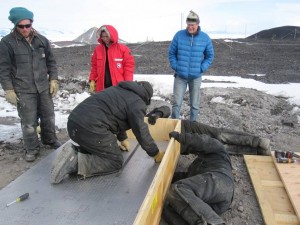
It’s a tough job to unpack the optical bench from its crate – crawling on volcano dust under cold weather!
Saturday, Nov. 27th, 2010, was the Thanksgiving holiday at McMurdo Station. Weichun, Wentao, and I walked to Arrival Heights in the nice sunshine of the day. It took about 50 minutes but was a very nice hike. After a few hours of work in Lab C, we walked back to McMurdo and had a nice thanksgiving dinner – the best dinner so far since we arrived here. We even had crab legs!
Sunday, the A-130 team finally found a little time for recreation. We checked out a radio, and then walked to the Hut Point where an observation tube was installed and extended under the sea ice. We climbed down the tube to watch the sea world under ice. Unfortunately, no penguins or seals were found. But we were very happy to walk on the slippery ice and had our group photo taken.
Finally, an unexpected story – I ran into Dr. Mark Clilverd of British Antarctica Survey at Arrival Heights (See photo below)! He was one of our team members for the Rothera lidar campaign from 2002 to 2005, and we met for the first time 8 years ago in Cambridge, UK. Now he “pretends” to be a Kiwi to visit his Very Low Frequency experiment. One Chinese phrase can summarize my feeling “他乡遇故知”! You may see the different ECW gears between USAP and ANZ on this photo.
We now have a platform to work with and we plan to get all the rest of the seven crates moved in and set up the entire lidar ASAP. Looking forward to our first light from McMurdo!
Sincerely,
Xinzhao
